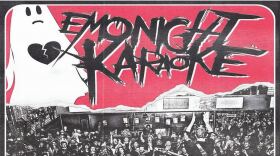Earlier this week, Thomas Starr took a walk along Route 108 in Durham, looking for a path to town landing, by the Oyster River. The path veers away from the bridge and drops down closer to the water.
"You see how the road dips down here? That's a concern, where that could flood," says Starr.
Starr is professor of graphic and information design at Northeastern University, and he thinks a lot about flooding, especially the kind attributed to climate change.

He leads the way to a plaque he designed, which reads: “Oyster River overtopped Route 108 during an extreme rain event and astronomical high tide - May 19, 2034.”
That’s right: a historical marker recalling something that happens 15 years from now.
"My concept was always to put some marker in the environment. So, in other words, get things off of pages and screens and get them on the street, in the landscape," he explains.
Starr says he wanted to make the threat of climate change more tangible, so he designed these circular metal plaques that commemorate major milestones in climate change and how communities respond to it.

It’s part of an art installation called “Remembrance of Climate Futures.” Plaques are fixed to posts Essex, Massachusetts, and will be soon in Cambridge as well.
Here in Durham, there are several, including one marking something that’s already happened: the arrival of Mississippi Kites, birds more accustomed to warm southern skies.
Listen to Starr discuss his project with NHPR's Peter Biello:
Have you seen a Mississippi kite in this location?
I have not. But as I said, I'm not really a bird watcher. But local bird watchers have documented this long before the project cited it.
All of the markers have QR codes on them. What will people see if they scan the QR codes?
Right. So the QR code is an important aspect because while we want people to be intrigued by these signs, they're a little bit puzzling or a little bit odd because they’re in the past tense with a future date for the most part. So we're hoping that people would investigate by using the QR code, which would take them immediately to a chronological directory of all the plaques that are up in Durham right now. There they could see all these other messages that might be in parts of town they'll never see and get a sense when these different types of things might occur. And then each one of those plaques and their dates has a button where they can read further and they would be able to read the background and the science of why we feel that this is an important issue that the town is paying attention to, and that is in climate reports. And most of those are footnoted with links to the actual report.
What kind of data did you use to imagine these plaques? Are they based in research or are they based in your imagination of what could happen in any given place?
No, my imagination does not play a part other than the general concept of using historical plaques and reverse dating things. But no, all of it comes from published scientific data that you can find on the town's website. To back up to what we're talking about with these QR codes, there is a link on what you get to on your phone that takes you to a description of the project, and from there to the town of Durham climate page, so that you can.. It's really like coming full circle. This is the device that gets people to pay attention to what Durham already has on the website, the actual information that the project is based on.
So what do you hope people get out of seeing and experiencing these historical markers?
Well, I hope that they would take more seriously things that are projected to be further in the future. May 2034 seems pretty far off, but actually it's not that far off. Right. 15 years. So that's something that's going to conceivably concern them. They're still maybe going to be living here. What this does is it kind of puts you in a future frame of mind, you know, for maybe a second or two while you try to figure out what the sign is about. And then you come back to the present, which is really the past in terms of this. So you're in the past and it's your present, then you could do something to affect the future.








